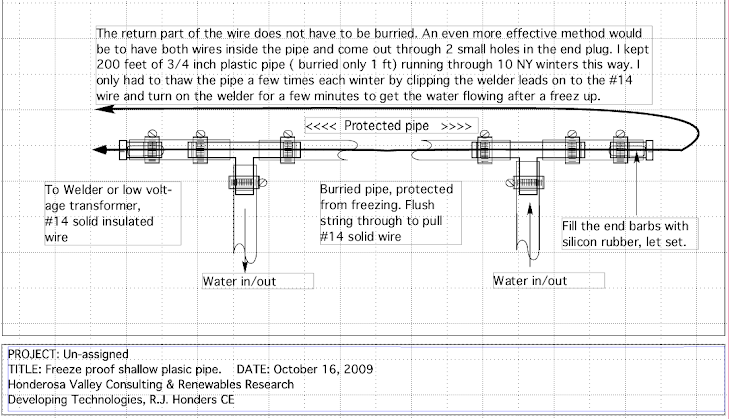
Find the WEB CAM in the picture ... Here I used the 6X6 plastic box on its back. The camera and the clear cylindrical food storage container is mounted on the box cover, and the Home Plug Ethernet Switch and camera power supply are all in the box. Just a pair of #18 wires powers the whole thing and carries the ethernet video signal back to the house and the internet. The camera works even on the coldest days (-5° F so far) because of the small amount of heat generated by the power supplies. Cost: IP camera-$80, One Home Plug-$50, Carlon 6X6 box and clear food container- $20. The other end at the house costs about $70 plus 1000 feet of Cat 5 wire. The most expensive part is trenching and plastic conduit. But if you do it by hand you won't need that workout at the gym for a long time :)

POWER YOUR WEBCAMS AND SEND STREAMING VIDEO THOUSANDS OF FEET OVER ZIPCORD!
Yea, these little webcams, IP cams or internet cameras, are cheap (<$100). What costs is hooking them up using fiber optics over long distances. Wireless does not work over more than a few hundred feet and line of sight. You still have to run 120VAC to them, so why not send the streaming video over the same power wires? I've got 4 running now, the one in the power house is 1400' away! That one is just aimed at the circuit monitor meters.
These web-cams have web-servers built-in. That means they act just like a computer on the internet and you don't need a computer running all the time. The camera all by itself can send its imagery to anyone that logs on and requests it. You can set up the camera with user names and passwords, and you can access the camera from anywhere on the internet. I did have to learn a lot about IP addresses, port forwarding and such to get the first one to work. It took me a while to figure it all out, and then I went out and bought a different brand of camera and it was like I had to re learn everything all over again because it was all slightly different and it did not help that the manual was in Chinese or a very rough translation there-of.
Try http://www.powershack.shacknet.nu:1027/ Use Guest login. You'll be looking at the 2 Square D Power Monitors set to read out Amps @ 500V and 3 mirrors, the lower left mirror shows the control valve position, vertical black line is wide open, 45° is shut down to minimum power. The wide angle mirror gives a view of the inside of the power house. Also try the intake cam at http://powershack.shacknet.nu:1026/ (during daylight hours- will have night lights soon.) The biggest challenge was how to get ethernet to work at 1400 feet distances and at the same time get power to the camera. Now I had already installed cat 5 wire all the way to the powerhouse, but when I tried to connect the camera in the power house to my computer 1400' away at home I got nothing, even though it worked fine when there was anything less than about 500' of cat 5. I solved that problem by buying a pair of Netgear 'HomePlugs' for about $100. These things are designed to plug into any 120VAC outlet and have 4 ethernet connectors. They are intended for extending your ethernet network in a home by using the existing 120VAC power wiring in a house. So you plug one in the wall in the living room, plug your computer in to it, plug another one in, say in the den at the other end of the house, and plug in the second computer or any ethernet device.
Now I could not use the power line going between the power house and my house because it is 500VAC. So I paralleled 2 pairs in the cat 5 wire, and with some fuses and filtering essentially plugged the Cat 5 into 120VAC at the house, and a HomePlug at each end. (see drawing above for details) At the powerhouse end I also connected the wall wart that powers the webcam to the 120VAC that also powered the HomePlug, and then just plug in the ethernet cable from webcam to HomePlug. With this setup you could run 16 guage zip cord thousands of feet , power the webcam at the far end and get video streams at up to 85 Mb/sec. back over plain old zip cord. Some models of HomePlug go up to 250Mb/sec. !
The only other option I came across in my research was to run fiber-optic, but that would have cost 10 times what this setup cost me. In the mean time I have added 3 more webcams ( and 3 more HomePlugs) all in parallel on the same doubled up pair of #22 cat 5 wires and I can't really see much degradation in speed or image quality. I have all my long distance wire underground in conduit. If you plan overhead wire you'll need to consider more fuses and surge suppressors in case of lightening strikes. Even my underground wire got enough of a surge during a recent thunder storm to blow a 1 Amp fuse, but no other damage.
Disclaimer: 120VAC is dangerous and should only be used with the proper wire in the proper conduits and with the correct fusing and ground fault protection. Only qualified persons should deal with electricity. The unqualified may be fried!
http://www.netgear.com/Products/PowerlineNetworking/PowerlineEthernetAdapters/XE104.aspx
These are the links to the NetGear hardware.









1 comment:
Http://www.netgear.com/products/home/powerline-and-coax/simplesharing/XEB1004.aspx
This is the updated XE104 information.
Post a Comment